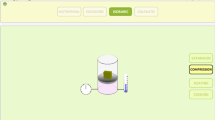Abstract
This paper describes the design and development of an interactive learning environment inspired from the constructivist view of learning and aiming at helping students improve their conceptions about chemical equilibrium. The design of the software was based on data that emerged from research we undertook with 175 Greek students (aged 17–18), in order to detect their conceptions and learning difficulties about chemical equilibrium. The students' answers to a written questionnaire showed that they had inadequate representations of systems of substances at chemical equilibrium related to the empirical and the atomic level, manifested serious difficulties in conceiving the initial situation of a system at chemical equilibrium and the equilibrium shift, made overextended use of the Le Chatelier principle and applied intuitive personal rules instead of the equilibrium constant law. The aim of this computer application is to help students to create and/or improve their own representations about substances at chemical equilibrium in the empirical, atomic and symbolic level, to establish appropriate links among thes multiple representations, and to construct appropriate conceptions about the Le Chatelier principle and the equilibrium constant law. The software contains simulations and visualizations of experiments representing systems at chemical equilibrium, simulations of chemical reactions related to the atomic level, symbolic representations and dynamic graphs, and a step-by-step derivation of the equilibrium constant law.
Similar content being viewed by others
References
Banerjee, A. C. (1991) Misconceptions of students and teachers in chemical equilibrium. International Journal of Science Education, 13, 487–494.
Ben-Zvi, R., Eylon, B. and Silberstein, J. (1987) Students' visualisation of a chemical reaction. Education in Chemistry, 24, 117–120.
Borghi, L., De Ambrosis, A., Falomo, L. and Mascheretti, P. (1993) Environnements multimédias pour l'étude de la physique. Didascalia, 2, 49–59.
Camacho, M. and Good, R. (1989) Problem-solving and chemical equilibrium: successful versus unsuccessful performance. Journal of Research in Science Teaching, 26, 251–272.
Draper, S., Brown, M., Henderson, F. and McAteer, E. (1996) Integrative evaluation: an emerging role for classroom studies of CAL. Computers in Education, 26(1-3), 17–32.
Fensham, P. (1988) Familiar but different: some dilemmas and new directions in science education. In Development and Dilemmas in Science Education, P. Fensham (ed), The Falmer Press, Great Britain, pp. 1–26.
Garnett, P. J., Garnett, P. J. and Hackling, M. W. (1995) Students' alternative conceptions in chemistry: a review of research and implications for teaching and learning. Studies in Science Education, 25, 69–95.
Gorodesky, M. and Gussarsky, E. (1986) Misconceptualisation of the chemical equilibrium concept as revealed by different evaluation methods. European Journal of Science Education, 8(4), 427–441.
Hameed, M., Hackling, M. W. and Garnett, P. J. (1993) Facilitating conceptual change in chemical equilibrium using a CAI strategy. International Journal of Science Education, 15, 221–230.
Hennessy, S., Twigger, D., Driver, R., O'Shea, T., O'Malley, C., Byard, M., Draper, S., Hartley, R., Mohamed, R. and Scanlon, E. (1995) Design of a computer-augmented curriculum for mechanics. International Journal of Science Education, 17(1), 75–92.
Hewson, P. W. and Hewson, M. G. (1984) The role of conceptual conflict in conceptual change and the design of science instruction. Instructional Science, 13, 1–13.
Hopey, C. (1995) Making the Right Choice: Software Evaluation. Office of Educational Research and Improvement (ED), Washington, DC.
Hyde, R. T., Shaw, P. N. and Jackson, D. E. (1996) The evaluation of integrated courseware: can interactive molecular modelling help students understand three-dimensional chemistry? Computers and Education, 26(4), 233–239.
Johnstone, A. H. (1991) Why science is dif®cult to learn? Things are seldom what they seem. Journal of Computer Assisted Learning, 7, 75–83.
Johnstone, A. H., MacDonald, J. J. and Webb, G. (1977) Chemical equilibrium and its conceptual difficulties. Education in Chemistry, 14, 169–171.
Kozma, R., Russell, J., Jones, T., Marx, N. and Davis, J. (1996) The use of multiple, linked representations to facilitate science understanding. In International Perspectives on the Design of Technology-Supported Learning Environments, S. Vosniadou, E. de Corte, R. Glaser and H. Mandl (eds), Lawrence Erlbaum Associates, Mahwah, NJ, pp. 41–60.
Niaz, M. (1995a) Relationship between student performance on conceptual and computational problems of chemical equilibrium. International Journal of Science Education, 17, 343–355.
Niaz, M. (1995b) Cognitive conflict as a teaching strategy in solving chemistry problems: a dialecticconstructivist perspective. Journal of Research in Science Teaching, 32, 959–970
Nurrenbern, S. C. and Pickering, M. (1987) Concept learning versus problem solving: is there a difference? Journal of Chemical Education, 71, 29–34.
Quílez-Pardo, J. and Solaz-Portolás, J.-J. (1995) Students' and teachers' misapplication of the Le Chatelier's principle: implications for the teaching of chemical equilibrium. Journal of Research in Science Teaching, 32(9), 939–957.
Raghavan, K. and Glaser, R. (1995) Model-based analysis and reasoning in science: the MARS curriculum. Science Education, 79(1), 37–61.
Rogers, L. T. (1995) The computer as an aid for exploring graphs. School Science Review, 76(276), 31–39.
Roth, W.-M. (1995) Authentic School Science. Kluwer Academic Publishers, Netherlands.
Sawrey, B. A. (1990) Concept learning versus problem solving: revisited. Journal of Chemical Education, 67, 253–334.
Squires, D. and McDougall, A. (1996) Software evaluation: a situated approach. Journal of Computer Assisted Learning, 12(3), 146–161 Squires, D. and Preece, J. (1996) Usability and learning: evaluating the potential of educational software. Computers and Education, 27(1), 15±22.
Stavridou, H. and Solomonidou, C. (2000) Conceptions et représentations des étudiants par rapport au concept d' équilibre chimique. Didascalia, 16, 107–134.
Wilson, A. and Cavallari, B. (1995) OzChem: an Australian chemistry laboratory simulation. Active Learning, 3, 45–49.
Author information
Authors and Affiliations
Rights and permissions
About this article
Cite this article
SOLOMONIDOU*, C., STAVRIDOU, H. Design and Development of a Computer Learning Environment on the Basis of Students' Initial Conceptions and Learning Difficulties About Chemical Equilibrium. Education and Information Technologies 6, 5–27 (2001). https://doi.org/10.1023/A:1011359010331
Issue Date:
DOI: https://doi.org/10.1023/A:1011359010331




